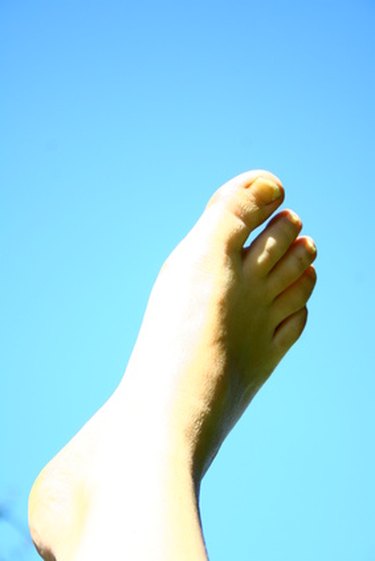
Pronation happens when your foot rolls toward the inside and flattens while walking or running. Some pronation is normal, but too much pronation can bring about foot, knee, ankle and hip injuries. Supination, or “underpronation,” happens when your weight is supported on the foot’s outside edge. With supination, you might not get adequate natural cushioning with each step, Mark Fenton writes in “The Complete Guide to Walking.” The proper shoes can correct problems, but first you need to determine your foot’s pronation. In general, people with high arches are more likely to have supination issues, and people with “flat feet” more often have excessive pronation, North Dakota State University explains. Your best bet is to visit a sports-medicine podiatrist, but you can also perform certain tests at home to determine foot pronation.
Things You'll Need
Old running or walking shoe
Water
Flat surface, like a brown bag
Video of the Day
Shoe Method
Step 1
Examine a pair of your old walking or running shoes. Find the wear pattern on the outsoles of your shoes.
Video of the Day
Step 2
Look for excessive wear on the outsole’s inside edge. If this exists, you have overpronation. This foot pattern is more common than the pattern for too much supination. Choose a new pair of shoes that have a straight last. The last is the shape of the substance — generally metal or wood — that your shoe is built around, NDSU notes.
Step 3
Seek excessive wear on the outside edge of your outsole after you rule out overpronation. If this exists you have a supinator, or underpronation, pattern. Purchase shoes with extra cushioning and a curved last if you have a supination pattern.
Step 4
Choose shoes for a normal pronation pattern if you have a wear pattern that goes from the outside edge of your outsole’s heel toward the outsole’s center at the forefoot. Most people have this type of foot pattern, according to NDSU. Your shoes should have a semi-curved last.
Wet Foot Method
Step 1
Get your entire foot wet. The “wet test” is the most common method of determining foot pronation, according to the Running Warehouse website.
Step 2
Step on a brown grocery bag, a paper towel or other flat surface. Put your entire weight on your foot, advises NDSU.
Step 3
Look to see if your whole foot is outlined. If so, consider yourself an overpronator.
Step 4
View the footprint to see if none or little of the middle of your foot shows on the surface. If this is the case, you have a supination pattern.
Step 5
Rule out both overpronation and supination if half of your arch shows in your footprint pattern, advises NDSU.
Tip
See your doctor if you have persistent or excessive foot pain.